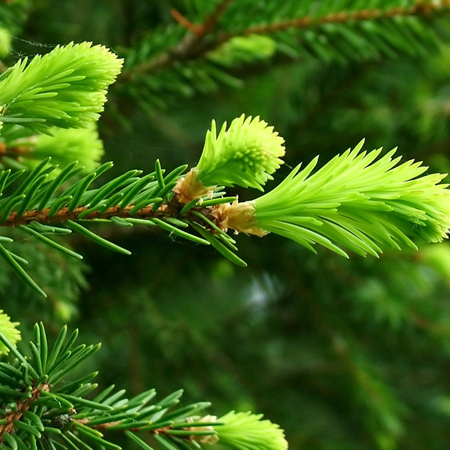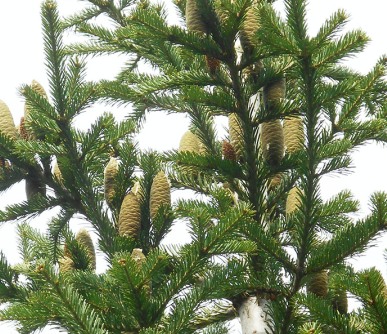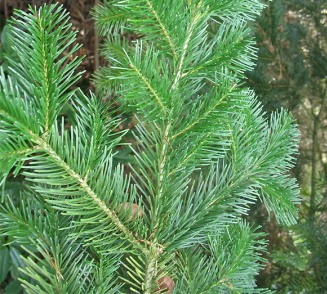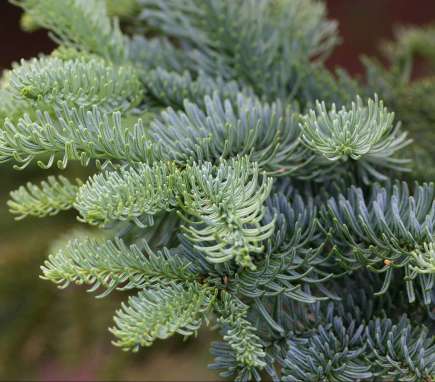




Botanical name Abies sibirica Ledeb
Synonyms Russian fir, Siberian silver fir, Siberian pine needle
Synonym Balsam fir, fir balsam
Family Pinaceae
Source Needles (leaves) and twigs
Origin Russia
Processing Method Steam Distillation
Color/Consistency A medium, clear, colourless to pale yellow liquid.
Aromatic Summary / Note / Strength of Aroma A middle note of strong aroma, Fir Balsam Essential Oil has the crisp, clean scent of fir balsam needles.
Blends With Cedar wood, Pine, Benzoin, Lavender, Patchouli, Spruce and Rosemary
Product Abstract
Like so many popular essential oils, fir needle essential is extracted through a process of steam distillation from fir needles, primarily from the species Abies balsamea. The needles are the most important part of this plant, as that is where the active ingredients and powerful chemical compounds are located. Once the essential oil is extracted, it can be used for a wide variety of applications, notably in the form of topical ointments or additives to other carrier oils that have other health properties. The combination of tricyclene, a-pinene, borneol, limonene, acetate, and myrcene all combine for these impressive health effects.
History
First described in 1768, balsam fir is a medium-sized tree generally reaching 40-60 feet in height and 1-1 1/2 feet in diameter. It exhibits a relatively dense, dark-green, pyramidal crown with a slender spire-like tip. The scientific name "balsamea" is an ancient word for the balsam tree, so named because of the many resinous blisters found in the bark. Balsam fir and Fraser fir have many similar characteristics, although geographic ranges of the two species do not overlap.
Dr. Wooster Beech (1794-1868), founder of the Eclectic healing movement, regarded balsam fir as a stimulant and laxative when taken internally and as an emollient and coolant when used externally.
Harvesting/Extraction Information
The antibacterial activity of the essential oil of Abies balsamea (balsam fir) was evaluated against Escherichia coli and Staphylococcus aureus. The essential oil of A. balsamea was found to be inactive against E. coli (>100 µg/mL) and active against S. aureus, with an MIC of 56 µg/mL. The oil composition was analysed by GC-MS and the antibacterial activity of each oil constituent was determined.
Common Usage
Caution
Despite the versatility of this particular essential oil, it is important to never consume essential oils internally. Inhalation in the form of aromatherapy is safe in certain situations, but it is always better to speak with an herbalist or an aromatherapist before embarking on this sort of alternative treatment. Also, due to the high concentration of chemicals in these oils,undiluted oils can be very powerful and dangerous when your skin is directly exposed to it.
Key constituents
Bornyl acetate 31.0%
Camphene 24.2%
a-Pinene 13.7%
d-3-Carene 12.2%
(þ)-Limonene 4.0%
Santene 2.5%
Tricyclene 2.4%
b-Phellandrene 2.4%
b-Pinene 1.6%
Borneol 1.6%
Terpinolene 1.1%
Quality Fir needle oil may be adulterated with turpentine oil, with mixtures of camphene, pinene and bornyl acetate, or with other chemicals. The oil may contain up to 40% bornyl acetate.
Safety summary
Hazards Skin irritation (low risk); skin sensitization if oxidized. Cautions: Old or oxidized oils should be avoided.
Our safety advice
Because of its (þ)-limonene, a-pinene and d-3-carene content we recommend that oxidation of Siberian fir needle oil is avoided by storage in a dark, airtight container in a refrigerator. The addition of an antioxidant to preparations containing it is recommended.
Regulatory guidelines
Essential oils derived from the Pinaceae family, including Pinus and Abies genera, should only be used when the level of peroxides is kept to the lowest practicable level, for example by the addition of antioxidants at the time of production.
Organ-specific effects
Adverse skin reactions: Undiluted Siberian fir needle oil was moderately irritating to rabbits; tested at 2.5% on 25 volunteers it produced a mild irritation, but no sensitization reactions (Opdyke 1975 p. 450). Autoxidation products of (þ)- limonene, a-pinene and d-3-carene can cause skin sensitization.
Systemic effects
Acute toxicity Acute oral LD50 in rats 10.2 g/kg; acute dermal LD50 in rabbits >3 g/kg (Opdyke 1975 p. 450).
Carcinogenic/anticarcinogenic potential No information was found ! for Siberian fir needle oil, but it contains no known carcinogens. (þ)-Limonene is anticarcinogenic
Comments
The oil is produced in large quantities, and is widely used in wash products and air fresheners.